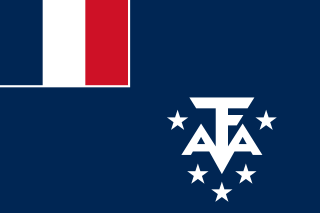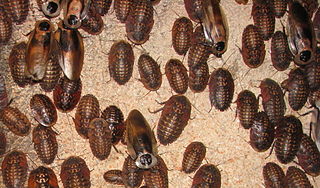
Europa Island, in Malagasy Nosy Ampela is a 28-square-kilometre (11 sq mi) low-lying tropical atoll in the Mozambique Channel, about a third of the way from southern Madagascar to southern Mozambique. The island had never been inhabited until 1820, when the French family Rosier moved to it. The island officially became a possession of France in 1897.

The striated heron also known as mangrove heron, little green heron or green-backed heron, is a small heron, about 44 cm tall. Striated herons are mostly sedentary and noted for some interesting behavioral traits. Their breeding habitat is small wetlands in the Old World tropics from west Africa to Japan and Australia, and in South America and the Caribbean. Vagrants have been recorded on Oceanic islands, such as Chuuk and Yap in the Federated States of Micronesia, the Marianas and Palau; the bird recorded on Yap on February 25, 1991, was from a continental Asian rather than from a Melanesian population, while the origin of the bird seen on Palau on May 3, 2005 was not clear.

Giant cockroaches, or blaberids are the second-largest cockroach family by number of species.

The american cockroach is the largest species of common cockroach, and often considered a pest. In certain regions of the U.S. it is colloquially known as the waterbug, though it is not a true waterbug since it is not aquatic. It is also known as the ship cockroach, kakerlac, and Bombay canary. It is often misidentified as a palmetto bug.

The Florida woods cockroach or palmetto bug is a large cockroach species which typically grows to a length of 30–40 mm (1.2–1.6 in). When alarmed, adults can eject an extremely foul-smelling directional spray up to 1 m, which inspired several of its other common names: Florida skunk roach, Florida stinkroach, skunk cockroach, skunk roach, stinking cockroach, and stinkroach. Two other naming variations include Florida cockroach and Florida woods roach.

The oriental cockroach, also known as the waterbug or black cockroaches, is a large species of cockroach, adult males being 18–29 mm (0.71–1.14 in) and adult females being 20–27 mm (0.79–1.06 in). It is dark brown or black in color and has a glossy body. The female has a somewhat different appearance from the male, appearing to be wingless at a casual glance, but is brachypterous, having non-functional wings just below her head. She has a wider body than the male. The male has long wings, which cover three quarters of the abdomen and are brown in color, and has a narrower body. Both of them are flightless. The female oriental cockroach looks somewhat similar to the Florida woods cockroach and may be mistaken for it. Originally endemic to the Crimean Peninsula and the region around the Black Sea and the Caspian Sea, its distribution is now cosmopolitan.

The German cockroach, colloquially known as the croton bug, is a species of small cockroach, typically about 1.1 to 1.6 cm long. In color it varies from tan to almost black, and it has two dark, roughly parallel, streaks on the pronotum running anteroposteriorly from behind the head to the base of the wings. Although B. germanica has wings, it can barely fly, although it may glide when disturbed. Of the few species of cockroach that are domestic pests, it probably is the most widely troublesome example. It is very closely related to the Asian cockroach, and to the casual observer, the two appear nearly identical and may be mistaken for each other. However, the Asian cockroach is attracted to light and can fly like a moth, while the German cockroach cannot.

Blattodea is an order of insects that contains cockroaches and termites. Formerly, termites were considered a separate order, Isoptera, but genetic and molecular evidence suggests they evolved from within the cockroach lineage, cladistically making them cockroaches as well. The Blattodea and the mantis are now all considered part of the superorder Dictyoptera. Blattodea includes approximately 4,400 species of cockroach in almost 500 genera, and about 3,000 species of termite in around 300 genera.

Cockroaches are a paraphyletic group of insects belonging to Blattodea, containing all members of the group except termites. About 30 cockroach species out of 4,600 are associated with human habitats. Some species are well-known as pests.

The giant burrowing cockroach is also known as the rhinoceros cockroach, and Queensland giant cockroach. These cockroaches are native to Australia and mostly found in tropical and subtropical parts of Queensland. They are the world's heaviest species of cockroach and can weigh up to 30-35 grams and measure up to 7.5-8 cm (3.1 in) in length. It is a member of the family Blaberidae, which contains hundreds of species. It is part of the blaberid subfamily Geoscapheinae. It is prominent in the wild and can also be sold and kept as a pet.

The emerald cockroach wasp or jewel wasp is a solitary wasp of the family Ampulicidae. It is known for its unusual reproductive behavior, which involves stinging a cockroach and using it as a host for its larvae. It thus belongs to the entomophagous parasites.

Horsfield's bush lark is a species of lark which inhabits grassland throughout most of Australia and much of Southeast Asia. It is named for American naturalist Thomas Horsfield.

The black myotis is a vesper bat species from South and Central America.

The brown antechinus, also known as Stuart's antechinus and Macleay's marsupial mouse, is a species of small carnivorous marsupial of the family Dasyuridae. The males die after their first breeding season, and the species holds the world record for being the world's smallest semelparous mammal.

Blaptica dubia, the Dubia roach, orange-spotted roach, Guyana spotted roach, or Argentinian wood roach, is a medium-sized species of cockroach which grows to around 40–45 mm (1.6–1.8 in).

The Philippine pangolin or Palawan pangolin, also locally known as balintong, is a pangolin species endemic to the Palawan province of the Philippines. Its habitat includes primary and secondary forests, as well as surrounding grasslands. This species is moderately common within its limited range, but is at risk due to heavy hunting because of its valued scales and meat. This species is distinguished from the closely related Sunda pangolin by its smaller body-to-tail ratio, smaller scales, and a shorter head. It is listed as Critically Endangered by the IUCN, and Critically Endangered by the Palawan Council for Sustainable Development (PCSD).

Moniliformidae is a family of parasitic spiny-headed worms. It is the only family in the Moniliformida order and contains three genera: Australiformis containing a single species, Moniliformis containing eighteen species and Promoniliformis containing a single species. Genetic analysis have determined that the clade is monophyletic despite being distributed globally. These worms primarily parasitize mammals, including humans in the case of Moniliformis moniliformis, and occasionally birds by attaching themselves into the intestinal wall using their hook-covered proboscis. The intermediate hosts are mostly cockroaches. The distinguishing features of this order among archiacanthocephalans is the presence of a cylindrical proboscis with long rows of hooks with posteriorly directed roots and proboscis retractor muscles that pierce both the posterior and ventral end or just posterior end of the receptacle. Infestation with Monoliformida species can cause moniliformiasis, an intestinal condition characterized as causing lesions, intestinal distension, perforated ulcers, enteritis, gastritis, crypt hypertrophy, goblet cell hyperplasia, and blockages.
Blattabacterium is a genus of obligate mutualistic endosymbiont bacteria that are believed to inhabit all species of cockroach studied to date, with the exception of the genus Nocticola. The genus' presence in the termite Mastotermes darwiniensis led to speculation, later confirmed, that termites and cockroaches are evolutionarily linked.

Saltoblattella montistabularis is a species of jumping cockroach known only from Table Mountain near Cape Town, South Africa. Both the species and genus were newly described in 2009. Researchers nicknamed the species leaproach. Its jumping mechanism is similar in anatomical features and in performance to grasshoppers with which it shares its habitat. Like grasshoppers, it is able to jump between grass and sedge stems. Its ability to jump is unique among the approximately 4,000 known species of cockroaches. Since the discovery and description of S. montistabularis in 2009 at least 2 more species have been discovered - one from the Cape Cederberg, one from Bredasdorp and a third with black and white stripes from Mossel Bay and Nature's Valley. All these are in the fynbos belt along the southern Cape coast.
Elliptorhina is a genus of large, flightless, wood-inhabiting cockroaches comprising ten known species, nine of those found on the island of Madagascar and one, Elliptorhina lefeuvri, found on Europa Island.



















